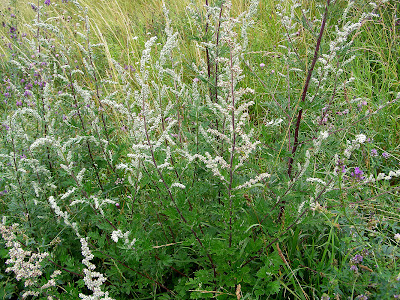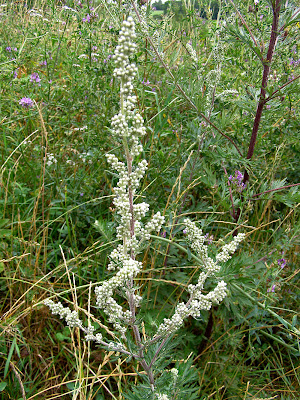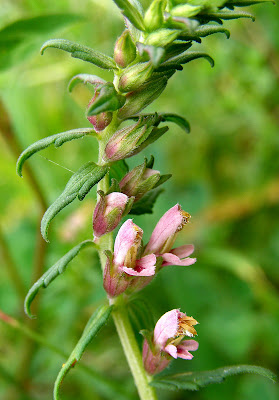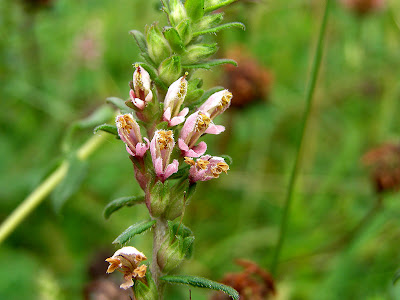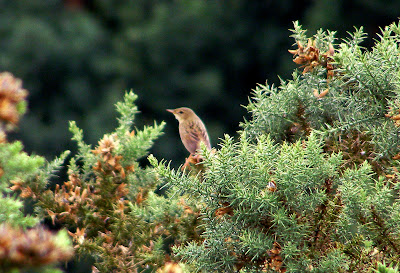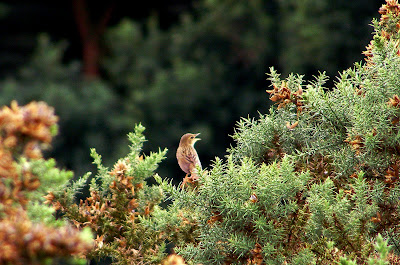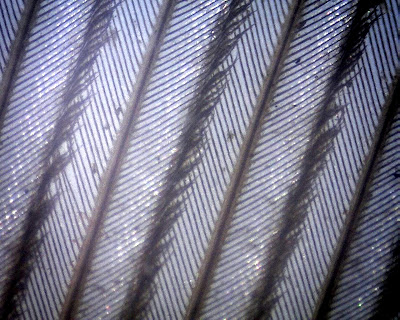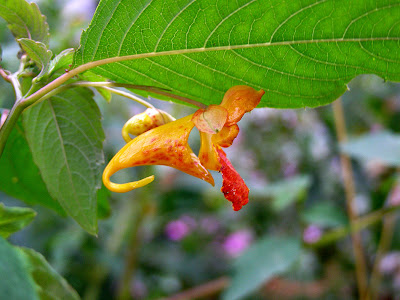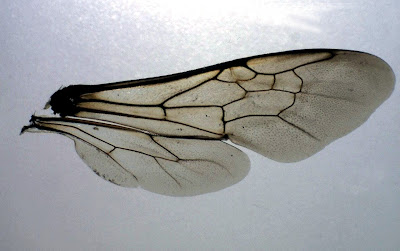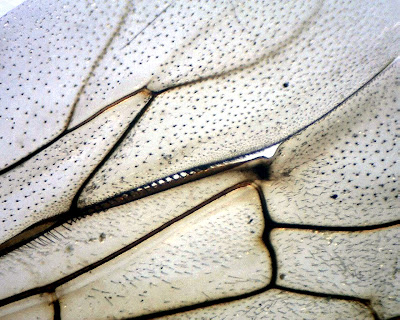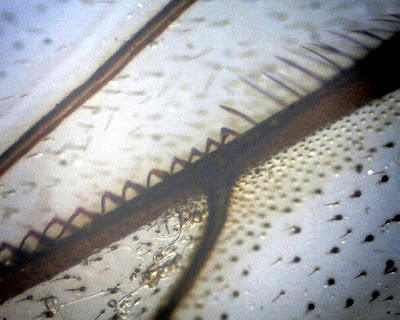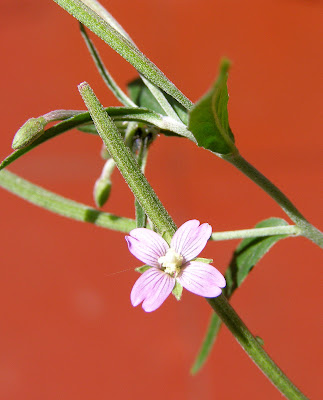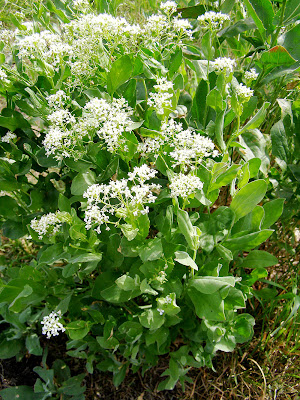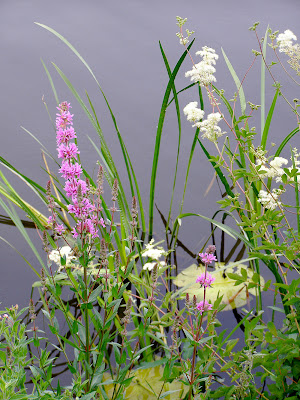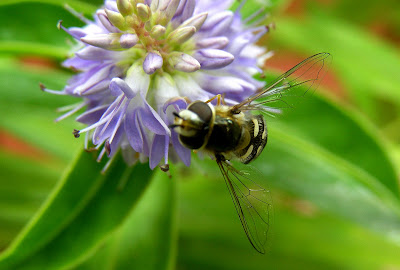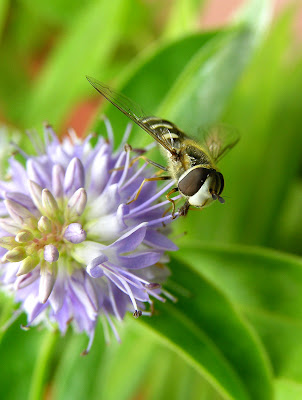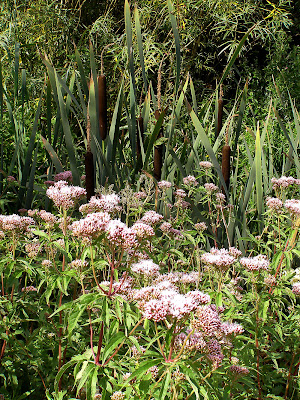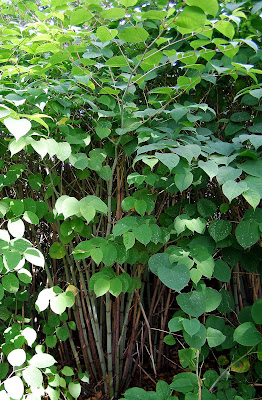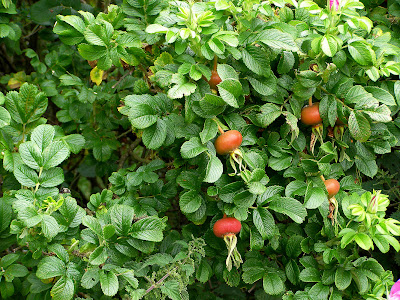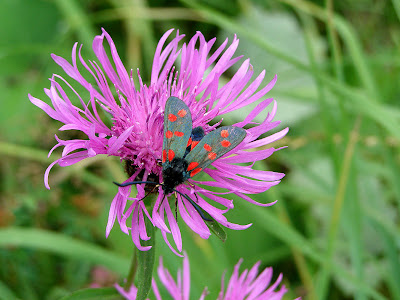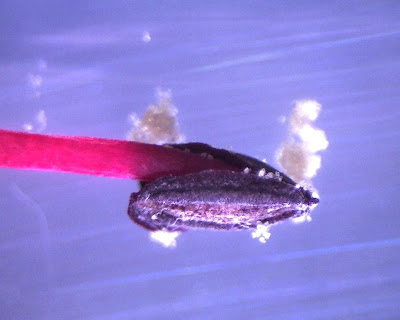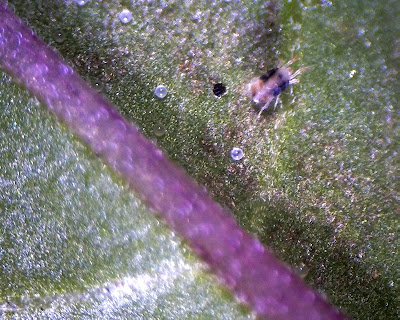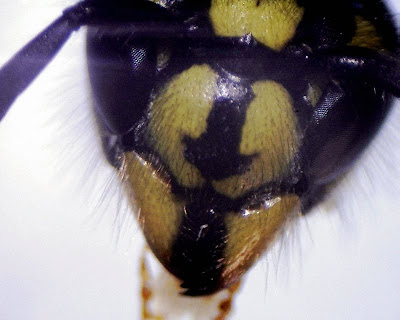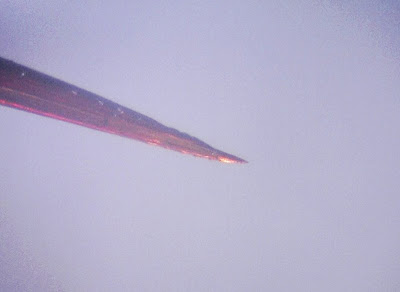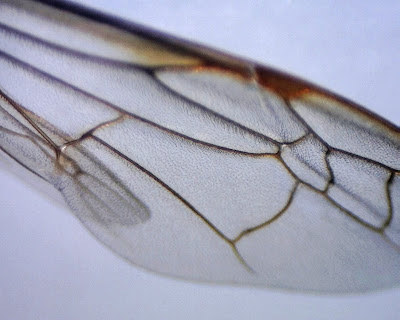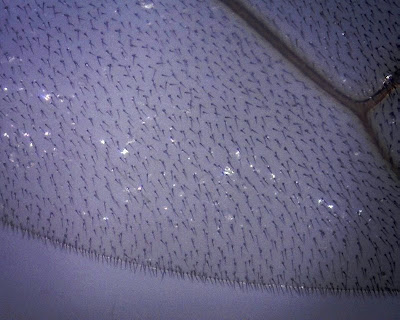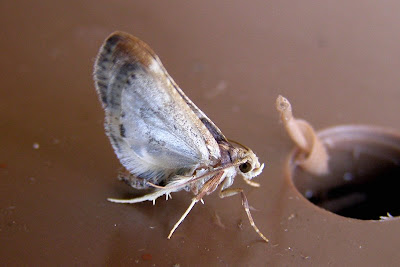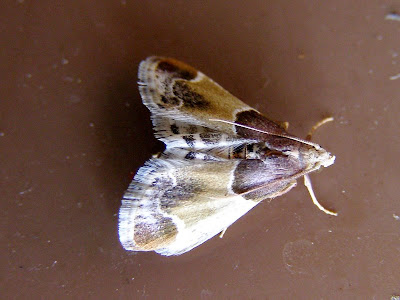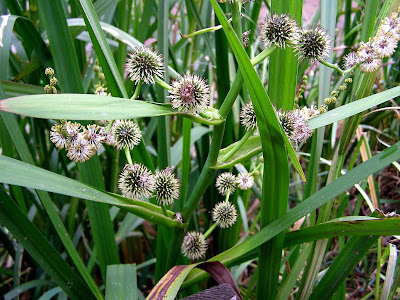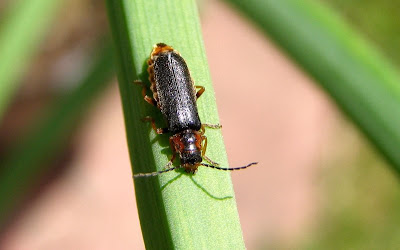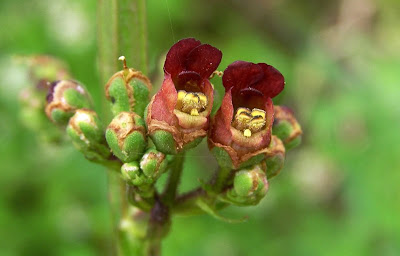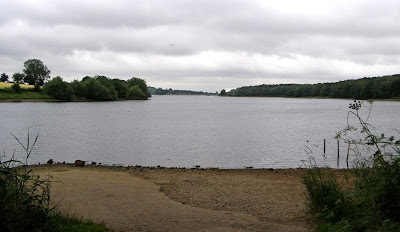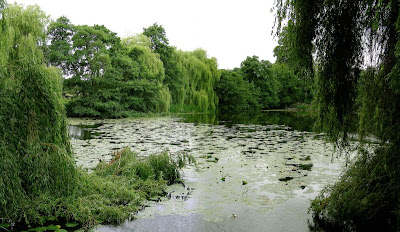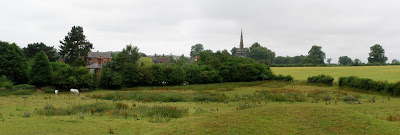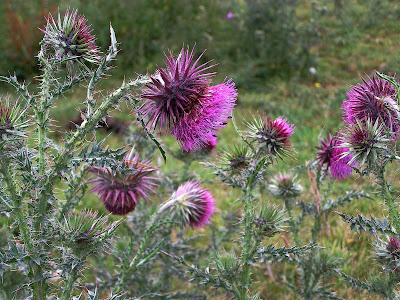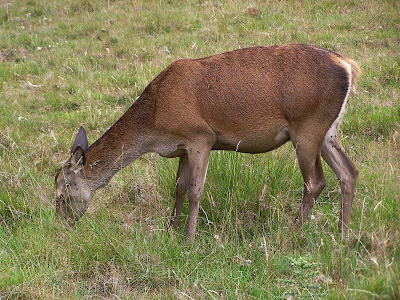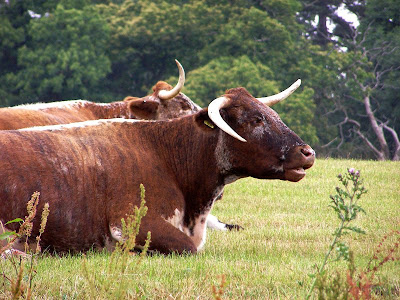On our short walk this morning, there was one plant in particular which caught my attention. Growing among the many members of the pea family which have made the old car-parks of the local Theme Park site, their home, was an impressive plant. Growing up to 5ft tall and grey-green in colour, with red, grooved stems and topped with hundreds of cottony, white flowers, the plant is called Mugwort (Artemisia vulgaris).
Also known as Common Wormwood, it has been used by humans for thousands of years in various medicinal compounds and even has links to witchcraft. Mugwort - like it's close relative Wormwood (Artemisia absinthium) - contains a chemical compound called thujone. This chemical is found in the infamous drink, Absinthe and may be responsible for that beverage's reported psychedelic effects. Recent research has shown that one would have to imbibe a huge amount of Absinthe in order to cause the reported mind-altering effects. In fact, your liver would 'alter' long before your mind!
Thujone is the substance which has been responsible for the plant's use in spells and witchcraft. Inducing hallucinogenic visions, it has been used as a smoking-herb and as an addition to pillows, inducing vivid dreams in the patient (victim?).
The flowers have also been used as a flavouring/seasoning for meats and fish. Picked before the flowers open, the young leaves have been used in the same way. The plant has been used as an anthelmintic drug for the removal of intestinal and parasitic worms.
Who would have thought so many uses would have been found for such a commonplace 'weed'.
As a footnote, in Ukranian, the plant is called Chornobylnik. The name of the abandoned city of Chernobyl means "place where Mugwort grows".
Welcome to my blog. Don't expect anything too high-tech or flashy, this is simply a 'diary' to share some of my photos, thoughts and observations - with a particular bias towards the natural world and the countryside around my home.
Saturday 31 July 2010
Friday 30 July 2010
Grasshopper
This morning's walk took us through Shipley Park and up the hill to the site of the old hall before descending the other side and walking around the old theme-park site, then returning home. While ascending Shipley Hill, we walked across a small meadow towards the trees at the edge of the hall's gardens. The meadow was filled with wild flowers including this little beauty, the Red Bartsia (Odontites verna).
The pinkish-purple flowers are borne along the length of the stems, arising from the leak axils (where the leaf joins the stem). You may remember the Yellow rattle i mentioned a few days ago (HERE), well, the Red Bartsia is a close relative of that plant and shares it's partially parasitic habits. Carder Bees and Solitary Bees are particularly fond of Red Bartsia.
A little later, as we descended the hill, we were given a real treat. The sight and sound of a Grasshopper Warbler (Locustella naevia) singing from a nearby bush.
It's usually rather difficult seeing these little birds as they have a habit of turning their head from side to side as they emit their reeling song which produces a ventriloquial effect. This makes it very tricky to pin-point where the sound is coming from.
For such a tiny bird, it has a remarkable migration taking it right down Europe, through Iberia across the Mediterranean and on through North Africa to it's wintering grounds in West Africa, south of the Sahara. It will be starting this epic flight very soon, usually in August. They begin setting out to return to our shores again between February and May. What a little wonder it is. And Malcolm just thought it was a 'little brown job'!
The pinkish-purple flowers are borne along the length of the stems, arising from the leak axils (where the leaf joins the stem). You may remember the Yellow rattle i mentioned a few days ago (HERE), well, the Red Bartsia is a close relative of that plant and shares it's partially parasitic habits. Carder Bees and Solitary Bees are particularly fond of Red Bartsia.
A little later, as we descended the hill, we were given a real treat. The sight and sound of a Grasshopper Warbler (Locustella naevia) singing from a nearby bush.
It's usually rather difficult seeing these little birds as they have a habit of turning their head from side to side as they emit their reeling song which produces a ventriloquial effect. This makes it very tricky to pin-point where the sound is coming from.
For such a tiny bird, it has a remarkable migration taking it right down Europe, through Iberia across the Mediterranean and on through North Africa to it's wintering grounds in West Africa, south of the Sahara. It will be starting this epic flight very soon, usually in August. They begin setting out to return to our shores again between February and May. What a little wonder it is. And Malcolm just thought it was a 'little brown job'!
Thursday 29 July 2010
Feather
There are few things in the natural world more complex and highly evolved than feathers. We take them so much for granted as we see them blowing about in the wind or lining a bird's nest, but they really do demand a closer look. Having found a primary (flight feather) from a House Sparrow (Passer domesticus) on our front garden this morning, I thought it would be good to have a closer look, under the microscope. Here, magnified 10 times, you can see the individual filaments separating along the trailing edge of the feather.
It has been suggested in the past, that feathers developed from reptilian scales - although this theory has been questioned in recent years. Each feather consists of a hollow shaft, quill or calamus, strong and very lightweight, tapering into a rachis as it gets towards the feather tip. From the rachis, there arise the many, soft barbs which interlock to form the main, vane structure (and the part we normally see). Each barb, is covered with even smaller, hook-like structures called barbules, which aid this interlocking. Birds can often be seen grooming and pulling their feathers through their beaks, this helps to 'zip' the barbs back together to maintain an unbroken surface area.
Feathers are made of the same material which goes to make up the bird's beaks and claws. This keratin protein is much the same thing as makes our finger nails and hair, although in birds, it much tougher.
The ends of these feathers look 'tatty' under the microscope, as they disintegrate into a fine powder which is combed into the feathers to help waterproof them. It is this powder (along with various feather parasites and their droppings) which can be such a problem to some people producing allergic reactions and breathing difficulties.
It has been suggested in the past, that feathers developed from reptilian scales - although this theory has been questioned in recent years. Each feather consists of a hollow shaft, quill or calamus, strong and very lightweight, tapering into a rachis as it gets towards the feather tip. From the rachis, there arise the many, soft barbs which interlock to form the main, vane structure (and the part we normally see). Each barb, is covered with even smaller, hook-like structures called barbules, which aid this interlocking. Birds can often be seen grooming and pulling their feathers through their beaks, this helps to 'zip' the barbs back together to maintain an unbroken surface area.
Feathers are made of the same material which goes to make up the bird's beaks and claws. This keratin protein is much the same thing as makes our finger nails and hair, although in birds, it much tougher.
The ends of these feathers look 'tatty' under the microscope, as they disintegrate into a fine powder which is combed into the feathers to help waterproof them. It is this powder (along with various feather parasites and their droppings) which can be such a problem to some people producing allergic reactions and breathing difficulties.
Wednesday 28 July 2010
Erewash Canal
This morning, Malcolm and I had a short walk along the Erewash Canal towards Potter's Lock before visiting an old friend.
The canal was completed in 1779 at a cost of some £21,000. It's main use was for the transportation of coal along it's 12 mile length between the town of Langley Mill and the River Trent.
These days, it is still used, but only for leisure purposes. The flora and fauna of the canal is quite rich and the water is full of Yellow and White Water-lilies and the banks are dotted with stands of Rosebay Willowherb.
There are a number of flowers which catch the eye as you walk along. Among the most colourful of these is the Orange Balsam (Impatiens capensis).
Introduced to Britain from North America, it is not to be found all over the country, but where it is found, it can be quite abundant. The origins of it's scientific name 'capensis' comes from a mistake. 'Capensis', means "of the cape" and is actually a misnomer, as Nicolaas Meerburgh - who named the plant - was under the mistaken impression that it was native to the Cape of Good Hope, in southern Africa. We all get thing wrong sometimes!
The canal was completed in 1779 at a cost of some £21,000. It's main use was for the transportation of coal along it's 12 mile length between the town of Langley Mill and the River Trent.
These days, it is still used, but only for leisure purposes. The flora and fauna of the canal is quite rich and the water is full of Yellow and White Water-lilies and the banks are dotted with stands of Rosebay Willowherb.
There are a number of flowers which catch the eye as you walk along. Among the most colourful of these is the Orange Balsam (Impatiens capensis).
Introduced to Britain from North America, it is not to be found all over the country, but where it is found, it can be quite abundant. The origins of it's scientific name 'capensis' comes from a mistake. 'Capensis', means "of the cape" and is actually a misnomer, as Nicolaas Meerburgh - who named the plant - was under the mistaken impression that it was native to the Cape of Good Hope, in southern Africa. We all get thing wrong sometimes!
Tuesday 27 July 2010
Bumble
Bumble Bees are fascinating things. The fact that they can fly at all is a matter of some discussion and comes from an ability to create lift from both the down-stroke and the up-stroke of each wing beat. There are four wings in all, two large front wings and two smaller hind wings. Here, seen at 10 times magnification with the main veins and some the tiny wing hairs visible.
The rear wings are attached to the fore-wings by means of a series of minute hooks which grasp around the underside of the trailing edge of the fore-wings, making, in effect, one large wing surface. Here, seen at 60 times magnification.
Seen even closer, the hooks - called Hamuli - are obvious, as are the tiny hairs on the surface of the wings. Here, x200.
The wings beat up to 240 times per second but the bee cannot beat them at all until it's wing muscles reach 30 degrees C. It can do this even on cold days, by slipping it's wings 'out of gear' and vibrating the muscles independently of the wings, to warm them up, before re-engaging the wings and finally taking off. Brilliant!
The rear wings are attached to the fore-wings by means of a series of minute hooks which grasp around the underside of the trailing edge of the fore-wings, making, in effect, one large wing surface. Here, seen at 60 times magnification.
Seen even closer, the hooks - called Hamuli - are obvious, as are the tiny hairs on the surface of the wings. Here, x200.
The wings beat up to 240 times per second but the bee cannot beat them at all until it's wing muscles reach 30 degrees C. It can do this even on cold days, by slipping it's wings 'out of gear' and vibrating the muscles independently of the wings, to warm them up, before re-engaging the wings and finally taking off. Brilliant!
Monday 26 July 2010
Odds and ends
No walk again this morning as we were hospital visiting again, so a few pictures and odds-and-ends from previous walks. Starting with a a small, but no less pretty flower from our garden. Related to the tall and elegant Rosebay (Epilobium angustifolium) and Greater Willowherb (Epilobium hirsutum), the Broad-leaved Willowherb (Epilobium montanum) is diminutive by comparison.
Not so long ago, I was trying to identify a plant which was giving me some problems. At the time, it was not in flower and the leaves were very like those of several other plants, but, as soon as the flowers opened and the plant matured, it became clear that it was Hoary Pepperwort (Lepidium draba). A member of the cabbage family, it is native to eastern Europe and Western Asia, but has become rather a nuisance plant in many parts of the world, rather like the Japanese Knotweed I mentioned previously.
The tall and beautiful Purple Loosestrife (Lythrum salicaria) is a member of the same family as the Pomegranate (Punica granatum) and the well-known house plant known as a Cigar plant (Cuphea ignea), but strangely, it is no relative of the other British wildflowers which share the name Loosestrife. This one was growing along the banks of the Mapperley Reservoir.
Lastly for today. another tall plant, this time a yellow flowered one called Tall Melilot (Melilotus altissimus). This is yet another member of the pea family which, as we have seen, is such a large and diverse family of plants. The Tall Melilot is a very common species in these parts and it covers large areas of the car parks around the old American Adventure Theme Park.
Not so long ago, I was trying to identify a plant which was giving me some problems. At the time, it was not in flower and the leaves were very like those of several other plants, but, as soon as the flowers opened and the plant matured, it became clear that it was Hoary Pepperwort (Lepidium draba). A member of the cabbage family, it is native to eastern Europe and Western Asia, but has become rather a nuisance plant in many parts of the world, rather like the Japanese Knotweed I mentioned previously.
The tall and beautiful Purple Loosestrife (Lythrum salicaria) is a member of the same family as the Pomegranate (Punica granatum) and the well-known house plant known as a Cigar plant (Cuphea ignea), but strangely, it is no relative of the other British wildflowers which share the name Loosestrife. This one was growing along the banks of the Mapperley Reservoir.
Lastly for today. another tall plant, this time a yellow flowered one called Tall Melilot (Melilotus altissimus). This is yet another member of the pea family which, as we have seen, is such a large and diverse family of plants. The Tall Melilot is a very common species in these parts and it covers large areas of the car parks around the old American Adventure Theme Park.
Saturday 24 July 2010
Much Less Bover!
The old advert for Flymow said it was " Much less bover than a hover". This could never apply to the enchanting little insects to be found in great profusion around are gardens at this time of year, collectively called the Hoverflies. They are no 'bover' at all, indeed they are a great asset to the gardener as they pollinate flowers and their larvae often feed on garden pests such as aphids.
There are over 200 different Hoverfly species in about 200 different families throughout the globe and they can be found on every continent except Antarctica, with about 300 separate species in Britain. Many have become wonderful mimics of other insects, particularly the wasps and bees, some are very difficult to distinguish from the 'real' thing. This one, on the Hebe flowers on our patio, was a little charmer..
This is a female - identified because it's eyes have a large gap between them towards the top of the head, males eyes tend to have no gap and appear to touch at the top. I am still trying to positively identify this fly, not an easy task when there are so many species and many look very similar.
On our walk this morning, it was nice to see the waterside plants beginning to flower in the warm sunshine. A particular favourite of mine is the Hemp Agrimony (Eupatorium cannabinum). Related to the Daisies and Chrysanthemums, the flowers are many and tightly packed into the flower heads to form a 'fluffy' appearance. The flowers of the Hemp Agrimony are not only pretty in pink, but also very attractive to insects, especially to several butterflies species.
Among those native species, one highly problematic plant, on the list of the world's 100 most invasive species, is in evidence almost everywhere in Britain these days. The Japanese Knotweed (Fallopia japonica) is, in the right place a highly ornamental and statuesque plant, perfect for the larger garden where height and 'impact' are required. But, when that plant started to shake off the confines of ornamental gardens and spread around the countryside, a problem was born. The invasive root system and strong growth can damage foundations, buildings, flood defences, roads, paving, retaining walls and other architectural sites. It also crowds out other, native species.
So it is with some trepidation, that it's 8ft high stems are to be seen around these parts too.
The young stems, which mature to look like large bamboo canes, are edible and are supposed to taste rather like rhubarb, so perhaps we should all be going out and cutting it down to eat! That would at least help to keep it under control.
There are over 200 different Hoverfly species in about 200 different families throughout the globe and they can be found on every continent except Antarctica, with about 300 separate species in Britain. Many have become wonderful mimics of other insects, particularly the wasps and bees, some are very difficult to distinguish from the 'real' thing. This one, on the Hebe flowers on our patio, was a little charmer..
This is a female - identified because it's eyes have a large gap between them towards the top of the head, males eyes tend to have no gap and appear to touch at the top. I am still trying to positively identify this fly, not an easy task when there are so many species and many look very similar.
On our walk this morning, it was nice to see the waterside plants beginning to flower in the warm sunshine. A particular favourite of mine is the Hemp Agrimony (Eupatorium cannabinum). Related to the Daisies and Chrysanthemums, the flowers are many and tightly packed into the flower heads to form a 'fluffy' appearance. The flowers of the Hemp Agrimony are not only pretty in pink, but also very attractive to insects, especially to several butterflies species.
Among those native species, one highly problematic plant, on the list of the world's 100 most invasive species, is in evidence almost everywhere in Britain these days. The Japanese Knotweed (Fallopia japonica) is, in the right place a highly ornamental and statuesque plant, perfect for the larger garden where height and 'impact' are required. But, when that plant started to shake off the confines of ornamental gardens and spread around the countryside, a problem was born. The invasive root system and strong growth can damage foundations, buildings, flood defences, roads, paving, retaining walls and other architectural sites. It also crowds out other, native species.
So it is with some trepidation, that it's 8ft high stems are to be seen around these parts too.
The young stems, which mature to look like large bamboo canes, are edible and are supposed to taste rather like rhubarb, so perhaps we should all be going out and cutting it down to eat! That would at least help to keep it under control.
Friday 23 July 2010
6 spots
It was nice to get out for a walk again this morning having had other things to do for the past few days. So, after doing the household chores, it was off to the Ponds at Straw's Bridge to see what we could see.
There are a few ponds which, together make up the Straw's Bridge area. One of the quieter ones is the pond which, until recently was the temporary home of the Great Reed Warbler. Since that little bird has now gone, all is quieter still. Until the Coots start fighting.
Among the trees around this pond, there are many different shrubs and wild flowers. Some of the most impressive of these have to be the Shrub Roses. The flowers are beginning to fade now, but that means the fruits or 'hips' are starting to ripen. These particular hips are enormous and just starting to turn red.
The Greater Knapweed (Centaurea scabiosa) plants are still in full bloom and are proving a great attraction to many and various species of insect. This one was being visited by a 6-Spot Burnet Moth (Zygaena filipendulae).
Back home and a search around the garden revealed a number of wasps (much to Malcolm's consternation) and several of these Hoverflies (Syrphus ribesii). Easy to photograph as they are very trusting little creatures allowing you to get very close.
There are a few ponds which, together make up the Straw's Bridge area. One of the quieter ones is the pond which, until recently was the temporary home of the Great Reed Warbler. Since that little bird has now gone, all is quieter still. Until the Coots start fighting.
Among the trees around this pond, there are many different shrubs and wild flowers. Some of the most impressive of these have to be the Shrub Roses. The flowers are beginning to fade now, but that means the fruits or 'hips' are starting to ripen. These particular hips are enormous and just starting to turn red.
The Greater Knapweed (Centaurea scabiosa) plants are still in full bloom and are proving a great attraction to many and various species of insect. This one was being visited by a 6-Spot Burnet Moth (Zygaena filipendulae).
Back home and a search around the garden revealed a number of wasps (much to Malcolm's consternation) and several of these Hoverflies (Syrphus ribesii). Easy to photograph as they are very trusting little creatures allowing you to get very close.
Thursday 22 July 2010
Fuchsia
Another close-up view of a common thing today. The Fuchsia growing in our garden, was an obvious place to start - I told you I would be boring you all with more of this stuff - so I picked a flower and a leaf to take a look.
The first thing to mention is the Anther. Very clearly seen in a fuchsia flower as the stamens and stigma, project prominently below the petals. The anther is the pollen-producing, end part of the stamen. The fuchsia anther is held on the end of the filament to make up the whole stamen. Here, you can clearly see the anther and the pollen grains which are produced there. This image was 60 times magnified.
While looking at the under side of the fuchsia leaf, I spotted something moving. Too small to notice with the naked eye, it turned out to be a Two-spotted Spider Mite (Tetranychus urticae). I thought the little, white 'blobs' nearby were tiny drops of sap coming from the leaf, but after further investigation, they turn out to be the eggs of the Spider Mite. Here, again, magnified 60 times.
I was so impressed (I'm so easily pleased these days), that I thought I would take a short video of the mite feeding on the leaf sap, so here it is, this time magnified 200 times...
The first thing to mention is the Anther. Very clearly seen in a fuchsia flower as the stamens and stigma, project prominently below the petals. The anther is the pollen-producing, end part of the stamen. The fuchsia anther is held on the end of the filament to make up the whole stamen. Here, you can clearly see the anther and the pollen grains which are produced there. This image was 60 times magnified.
While looking at the under side of the fuchsia leaf, I spotted something moving. Too small to notice with the naked eye, it turned out to be a Two-spotted Spider Mite (Tetranychus urticae). I thought the little, white 'blobs' nearby were tiny drops of sap coming from the leaf, but after further investigation, they turn out to be the eggs of the Spider Mite. Here, again, magnified 60 times.
I was so impressed (I'm so easily pleased these days), that I thought I would take a short video of the mite feeding on the leaf sap, so here it is, this time magnified 200 times...
Wednesday 21 July 2010
Wasp
Once again, this blog entry comes with a warning to Malcolm - Don't look Malcolm!
I have just bought a USB microscope (a new toy - I'm so excited), to be able to see, in even closer detail, some of the finer points of our natural world. The microscope was cheap, from Aldi, but is proving to be well worth the price.
What a revelation it has already been. For instance, this is a Common Wasp (Vespula vulgaris) which strayed into our kitchen yesterday (sadly for the wasp, it didn't stray out again). At 60 times magnification, the face of this wasp shows it's strong mandibles, with which it chews wood, mixed with it's saliva to make the papery structure of the nest. You can also see the 'anchor' shaped mark on it's face which identifies it as a Common Wasp.
Of course, the most infamous part of the wasp, has to be it's sting. Indeed, this particular insect still managed to get it's revenge on me long after it was dead, by stinging me as I accidentally put my hand on it while focusing the microscope. Dangerous even in death! An image of the sting tip (magnified 200 times) reveals just how nasty it is. The pain of the wasp sting is caused by a toxic fluid containing a complex protein, which is injected through the needle-like sting as it penetrates the victim - me, in this case!
The wings of this insect are rather beautiful under the microscope. There are four of them, with the hind wings being considerably smaller than the fore-wings and seem to be attached along their length. Here seen x60.
Seen even closer, x200, you can see that the surface of their wings is covered with minute hairs - a fact which was news to me!
I will be boring the nation with more close-up pictures of various things in the future. You have been warned!
I have just bought a USB microscope (a new toy - I'm so excited), to be able to see, in even closer detail, some of the finer points of our natural world. The microscope was cheap, from Aldi, but is proving to be well worth the price.
What a revelation it has already been. For instance, this is a Common Wasp (Vespula vulgaris) which strayed into our kitchen yesterday (sadly for the wasp, it didn't stray out again). At 60 times magnification, the face of this wasp shows it's strong mandibles, with which it chews wood, mixed with it's saliva to make the papery structure of the nest. You can also see the 'anchor' shaped mark on it's face which identifies it as a Common Wasp.
Of course, the most infamous part of the wasp, has to be it's sting. Indeed, this particular insect still managed to get it's revenge on me long after it was dead, by stinging me as I accidentally put my hand on it while focusing the microscope. Dangerous even in death! An image of the sting tip (magnified 200 times) reveals just how nasty it is. The pain of the wasp sting is caused by a toxic fluid containing a complex protein, which is injected through the needle-like sting as it penetrates the victim - me, in this case!
The wings of this insect are rather beautiful under the microscope. There are four of them, with the hind wings being considerably smaller than the fore-wings and seem to be attached along their length. Here seen x60.
Seen even closer, x200, you can see that the surface of their wings is covered with minute hairs - a fact which was news to me!
I will be boring the nation with more close-up pictures of various things in the future. You have been warned!
Tuesday 20 July 2010
Urban
A shorter walk today with a more urban flavour. Malcolm and I needed to take a look at a couple of shops on, what is known locally as the Waterside Retail Park, so we decided to walk there, through town and make a full, circular route of it.
Mapping our route, it turns out we still managed to cover over three and a half miles, plus whatever distance we covered, up and down the isles of Focus and Poundstretcher. The walk took us along the new bypass which opened last year called Millership Way, the first time we have walked along this part of the road.
Here is our route...
I am hoping to add a few pictures of our walk a little later, but at the moment, I am having camera trouble and am attempting to rescue the pictures from my 'corrupted' storage card. So, fingers crossed and keep looking back!
Mapping our route, it turns out we still managed to cover over three and a half miles, plus whatever distance we covered, up and down the isles of Focus and Poundstretcher. The walk took us along the new bypass which opened last year called Millership Way, the first time we have walked along this part of the road.
Here is our route...
I am hoping to add a few pictures of our walk a little later, but at the moment, I am having camera trouble and am attempting to rescue the pictures from my 'corrupted' storage card. So, fingers crossed and keep looking back!
Monday 19 July 2010
New
I am always on the lookout for species new to me and as such, I was pleased to see this small moth sitting on our compost bin a few days ago.
At less than 1" long, it was tricky to get close enough to get a good picture, without disturbing it and making it fly away. As it was, it closed it's wings as I approached and stubbornly refused to open them again. It has taken a good deal of trawling through the 'net' to find out that it is a Meal Moth (Pyralis farinalis). The larvae of these moths are a particular problem as they (as the name implies) feed on various forms of milled 'meal' and stored grains. They are also known to eat hay and straw, dried fruits and even sugary sweets.
At less than 1" long, it was tricky to get close enough to get a good picture, without disturbing it and making it fly away. As it was, it closed it's wings as I approached and stubbornly refused to open them again. It has taken a good deal of trawling through the 'net' to find out that it is a Meal Moth (Pyralis farinalis). The larvae of these moths are a particular problem as they (as the name implies) feed on various forms of milled 'meal' and stored grains. They are also known to eat hay and straw, dried fruits and even sugary sweets.
Eventually, after a few minutes, the moth became a little more used to me pointing my camera at it and decided to open it's wings again to display it's full glory.
Another addition to my life-list of positively identified invertebrates. The search for 'new' species continues....
Sunday 18 July 2010
Trying times
No walk yesterday following the bad news of our friend Moira's illness and hospitalisation. So visiting at the new Derby Royal hospital was order of the day.
Chores and shopping this morning have kept us from our walk again today, but here are a couple of pictures from the 'archive' to be going on with. Firstly a plant from our walk around the reservoir at Staunton Harold. The Branched Bur Reed (Sparganium erectum) is a handsome, waterside plant. You will only find this plant growing at the sides of still or very slow flowing water as it is very easily uprooted and strong currents will tear it from it's foothold. The flowers are of single sex, but both sexes can be found on the same plant with the male flowers being held above the female ones. Fruits are covered in a water-repellent substance which makes them float about for several months, dispersing their seeds as they travel around.
Next an insect found in our garden and a curious little chap he is too. A Soldier Beetle (Cantharis fulvicollis) is related to the fireflies but is unable to produce light. They get their common, English name from the fact that many of the members of the family are red in colour and reminiscent of soldier's red coats. A most welcome visitor to the garden as they enjoy eating aphids among other things.
Lastly for today a common plant of the pathways around Shipley Park, the Water Figwort (Scrophularia auriculata). This impressive plant stands a good 5ft or more tall, but it's flowers are so unimpressive, that they are easily - and often - overlooked. It isn't until you get close enough to see the detail that the beauty of the flowers becomes clear. It also becomes clear at close range, that the plant is part of the same family as the well-known garden flowers known as Snapdragons (Antirrhinum sp.).
Chores and shopping this morning have kept us from our walk again today, but here are a couple of pictures from the 'archive' to be going on with. Firstly a plant from our walk around the reservoir at Staunton Harold. The Branched Bur Reed (Sparganium erectum) is a handsome, waterside plant. You will only find this plant growing at the sides of still or very slow flowing water as it is very easily uprooted and strong currents will tear it from it's foothold. The flowers are of single sex, but both sexes can be found on the same plant with the male flowers being held above the female ones. Fruits are covered in a water-repellent substance which makes them float about for several months, dispersing their seeds as they travel around.
Next an insect found in our garden and a curious little chap he is too. A Soldier Beetle (Cantharis fulvicollis) is related to the fireflies but is unable to produce light. They get their common, English name from the fact that many of the members of the family are red in colour and reminiscent of soldier's red coats. A most welcome visitor to the garden as they enjoy eating aphids among other things.
Lastly for today a common plant of the pathways around Shipley Park, the Water Figwort (Scrophularia auriculata). This impressive plant stands a good 5ft or more tall, but it's flowers are so unimpressive, that they are easily - and often - overlooked. It isn't until you get close enough to see the detail that the beauty of the flowers becomes clear. It also becomes clear at close range, that the plant is part of the same family as the well-known garden flowers known as Snapdragons (Antirrhinum sp.).
Friday 16 July 2010
Calke Abbey part 3
Last part today, of our ramble around Calke Abbey and the Staunton Harold Reservoir. A couple of pictures of the reservoir firstly. As we left the Abbey and church behind and said goodbye to the deer, we walked back down to the shore of the reservoir. Here, we were afforded the sight of a plane heading int East Midlands Airport, you can just see it in the middle of this picture. You can also see how dry the weather has been by the large expanse of 'beach' which has been exposed at the water's edge.
Some sections of the reservoir are picturesque in the extreme, with Weeping Willows cascading into the waters and lilies covering the surface with their pads and yellow flowers. Simply beautiful...
Having headed back along the entrance drive to the Abbey, we crossed the road which leads to the village of Ticknall and walked across a field which gave us a wonderful view of the village and the spire of the church of St. George which dominates the view from here. As usual, the church was covered with scaffolding, so the image was slightly (but only slightly) spoiled.
Among the most impressive plants which we saw on our walk, were the Musk Thistle (Carduus nutans) which were growing in the field from where the last view was taken. Fiercely spiny and frighteningly thorny, the flowers are a fantastic purple colour and require much closer (and careful) inspection. The many tiny, black, pollen beetles which were munching their way around the flowers were also appreciating them.
Another impressive plant was one of the crops grown by the local farmers. This was a field of Maize which we walked through earlier on our trek. The crops were all crying out for rain, so the showers which have fallen this week, have been very welcome.
Back to Jayne's house for coffee before returning home. Thanks again to Jayne for the walk and we look forward to the next one.
Some sections of the reservoir are picturesque in the extreme, with Weeping Willows cascading into the waters and lilies covering the surface with their pads and yellow flowers. Simply beautiful...
Having headed back along the entrance drive to the Abbey, we crossed the road which leads to the village of Ticknall and walked across a field which gave us a wonderful view of the village and the spire of the church of St. George which dominates the view from here. As usual, the church was covered with scaffolding, so the image was slightly (but only slightly) spoiled.
Among the most impressive plants which we saw on our walk, were the Musk Thistle (Carduus nutans) which were growing in the field from where the last view was taken. Fiercely spiny and frighteningly thorny, the flowers are a fantastic purple colour and require much closer (and careful) inspection. The many tiny, black, pollen beetles which were munching their way around the flowers were also appreciating them.
Another impressive plant was one of the crops grown by the local farmers. This was a field of Maize which we walked through earlier on our trek. The crops were all crying out for rain, so the showers which have fallen this week, have been very welcome.
Back to Jayne's house for coffee before returning home. Thanks again to Jayne for the walk and we look forward to the next one.
Thursday 15 July 2010
Calke Abbey part 2
Onward from the impressive, sweeping drive up to Calke Abbey, we stopped for a bite to eat and to give a few scathing looks at the noisy brat children which were causing havoc around the area, then it was time to press on.
Following the path around the estate, we were afforded a fine view of the Baroque mansion, itself.
The house was built on the site of a 12th century Augustinian Priory. The abbey was dissolved by Henry VIII and the present house was built between 1701 and 1704. Owned by the Harpur family for 300 years, it was passed to the National Trust in 1985 in lieu of death duties. There is a fine, old Monkey Puzzle tree (Araucaria araucana) in the grounds too as you can see here.
The church, sited a little way from the house has unusual status as a 'peculiar' outside the normal diocesan organisation. The original church was built in the late 16th Century and rebuilt in Gothic style by Sir George Crewe in 1827-9. It contains a number of monuments including one to Henry Harpur Crewe who gave Calke to the National Trust.
we were treated to the sight of a small herd of deer as we left the park. A mixture of Red (Cervus elaphus) and Fallow Deer (Dama dama) have grazed the parkland of the Abbey estate since about 1773. This female (hind) Red Deer was too interested in eating the grass to be bothered by me trying to take her picture, she was however, being bothered by the flies.
The flies were also pestering the herd of Longhorn Cattle in the grounds of the abbey. The Harpur-Crewe family traditionally kept Longhorns and they have recently been re-introduced to the site.
Following the path around the estate, we were afforded a fine view of the Baroque mansion, itself.
The house was built on the site of a 12th century Augustinian Priory. The abbey was dissolved by Henry VIII and the present house was built between 1701 and 1704. Owned by the Harpur family for 300 years, it was passed to the National Trust in 1985 in lieu of death duties. There is a fine, old Monkey Puzzle tree (Araucaria araucana) in the grounds too as you can see here.
The church, sited a little way from the house has unusual status as a 'peculiar' outside the normal diocesan organisation. The original church was built in the late 16th Century and rebuilt in Gothic style by Sir George Crewe in 1827-9. It contains a number of monuments including one to Henry Harpur Crewe who gave Calke to the National Trust.
we were treated to the sight of a small herd of deer as we left the park. A mixture of Red (Cervus elaphus) and Fallow Deer (Dama dama) have grazed the parkland of the Abbey estate since about 1773. This female (hind) Red Deer was too interested in eating the grass to be bothered by me trying to take her picture, she was however, being bothered by the flies.
The flies were also pestering the herd of Longhorn Cattle in the grounds of the abbey. The Harpur-Crewe family traditionally kept Longhorns and they have recently been re-introduced to the site.
More to come tomorrow..........
Subscribe to:
Posts (Atom)

